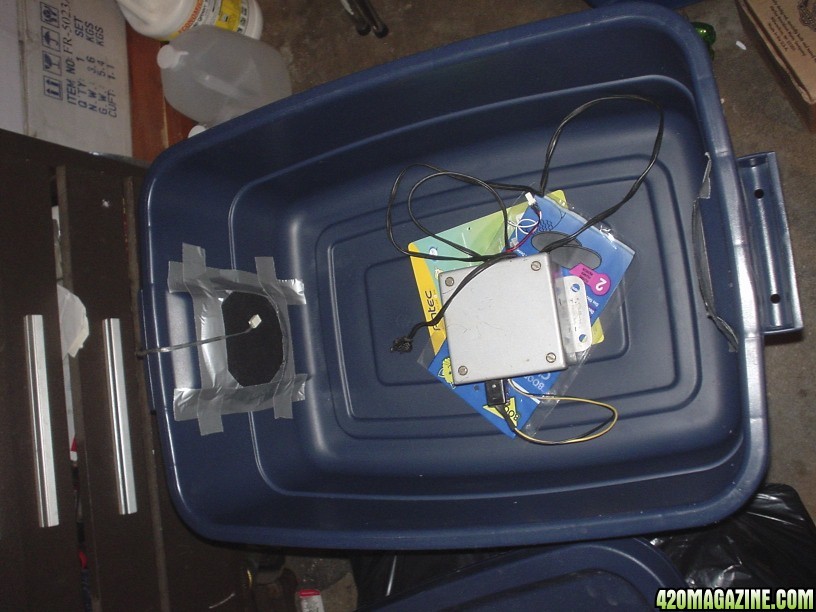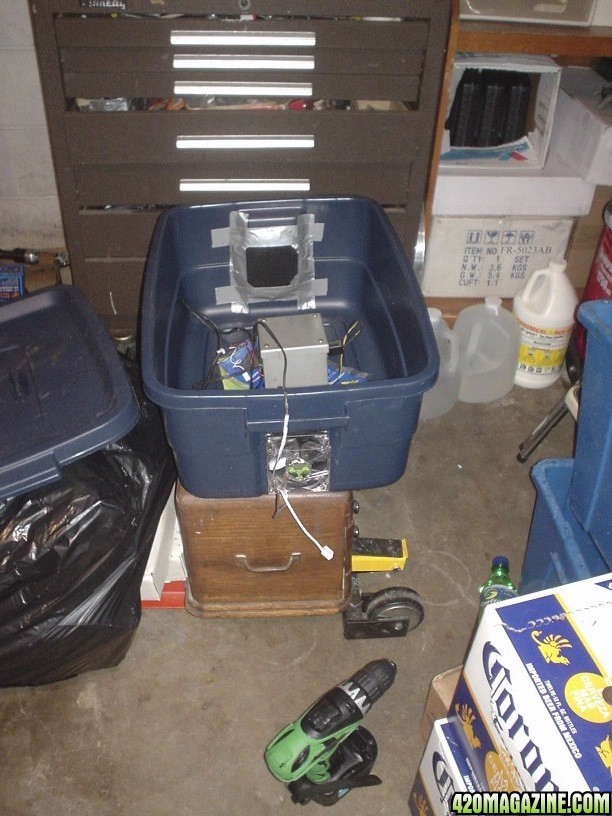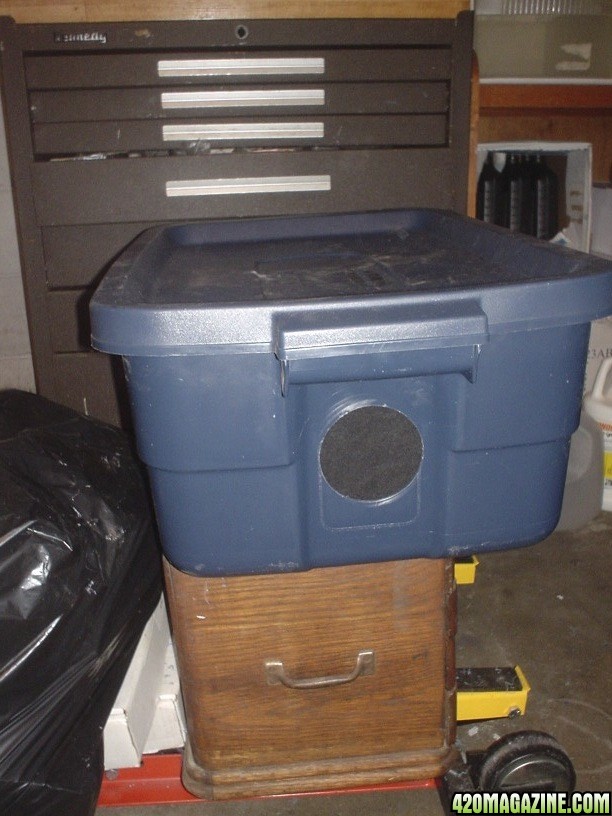SkooterClowns
Well-Known Member
The Goal
We (my brother and I) needed to set ourselves up a small grow. Like you, the readers of this forum, we wanted a steady supply, and hefty stash, of quality smoke. We also like the ability to do it. We've had very successful grows, on a larger scale, when we first used the method detailed in these posts. We find it very satisfying doing this. Almost as satisfying as smoking the stuff!
The plan
To use our proven method of growing some quality herbage using our method of hydroponic growing.
This method has worked great for us in the past and we were determined to successfully modify the operation to fit our current location limitations.
The conditions and limiting factors
This time our grow location and limiting factors are numerous. We had to significantly modify our normal operation to fit the following criteria:
Limited space
No "proper" ventilation
Temperature management
As many of you know the things that we found limiting are the very things that are needed to be satisfied to have any kind of grow that can be considered successful.
What we had to work with
A small corner of an attached, unheated garage. Our modified hydroponics system that we have had great success with in the past. All the necessary equipment as listed here.
QUALITY seeds (the grow shown here is Northern Lights chosen for it's high yield, height (short) and because of our successful past experience growing this strain)
2.5 Gallon Tub with spigot (tub must be "light tight")
Lid for tub with holes cut for the net cups
2 line air pump (aquarium quality, cheap)
air line tubing
2 Air stones
Exhaust fan and ducting
Timer
Herpastat
Ceramic heater (type used for reptile pets)
Fans (small box fan type)
Chemicals (Grow, Bloom, and Micro) typical of hydroponic grows
Net cups and covers
Rock wool
Roll of Mylar
Ph/PPM meter
Ph up/down liquids
400 watt lights and ballasts (HPS and MH bulbs) (Ballasts are great because they handle both types of bulbs)
Wireless thermometer
Hydrogen Peroxide
How we addressed the conditions and limiting factors
Limited space:
As stated we only had a small corner of an unheated garage ~4 square feet. We need to find a cabinet/container that would fit in the corner and provide enough room to fit our operation.
Eventually we found at our local Lowe's a plastic cabinet made by Suncast. It needed some modifications to make it light tight but we were confident that we could accomplish this. After all we were at a Lowe's, we're very ingenious (as are most growers) and determined to get this operation up and running.
We got ourselves some rigid insulation and some "metal" tape.
We used construction adhesive to apply the rigid insulation to the box.
We needed to cut holes in the box for hanging things and to get the cords out of it etc. We also used black plastic to help "light seal" where the doors meet when closed. The interior of the box measures 18"x23" after rigid insulation was installed.
The thing looks very stealth when in full operation. Came out GREAT if I do say so myself.
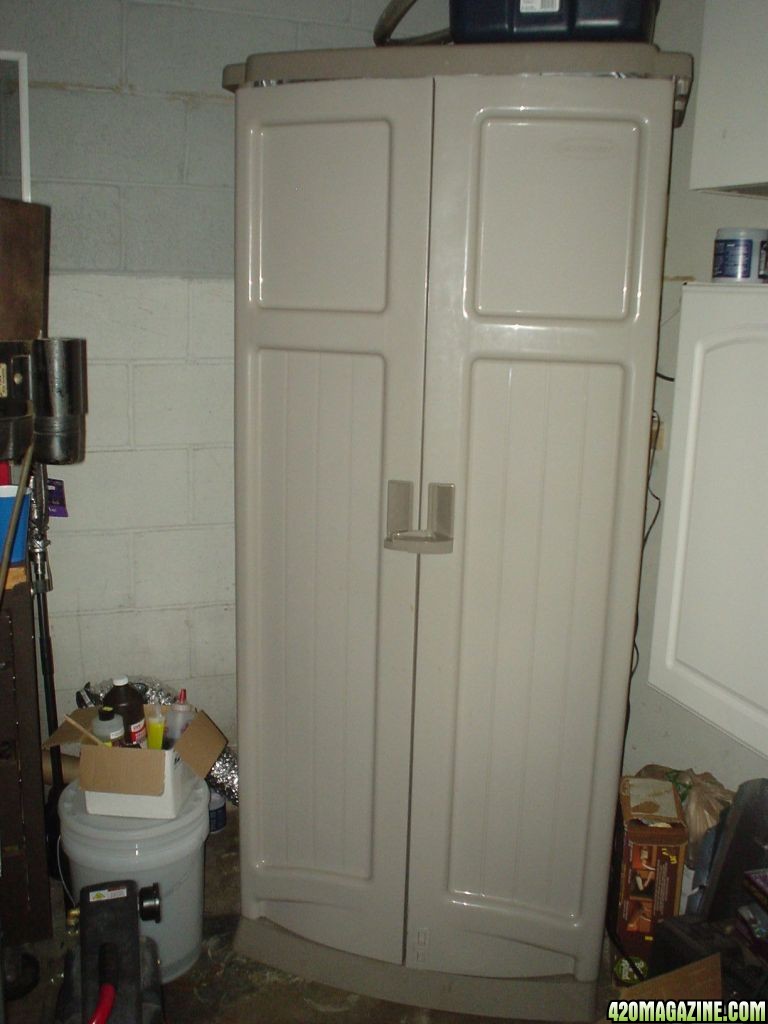
Exterior of our grow box
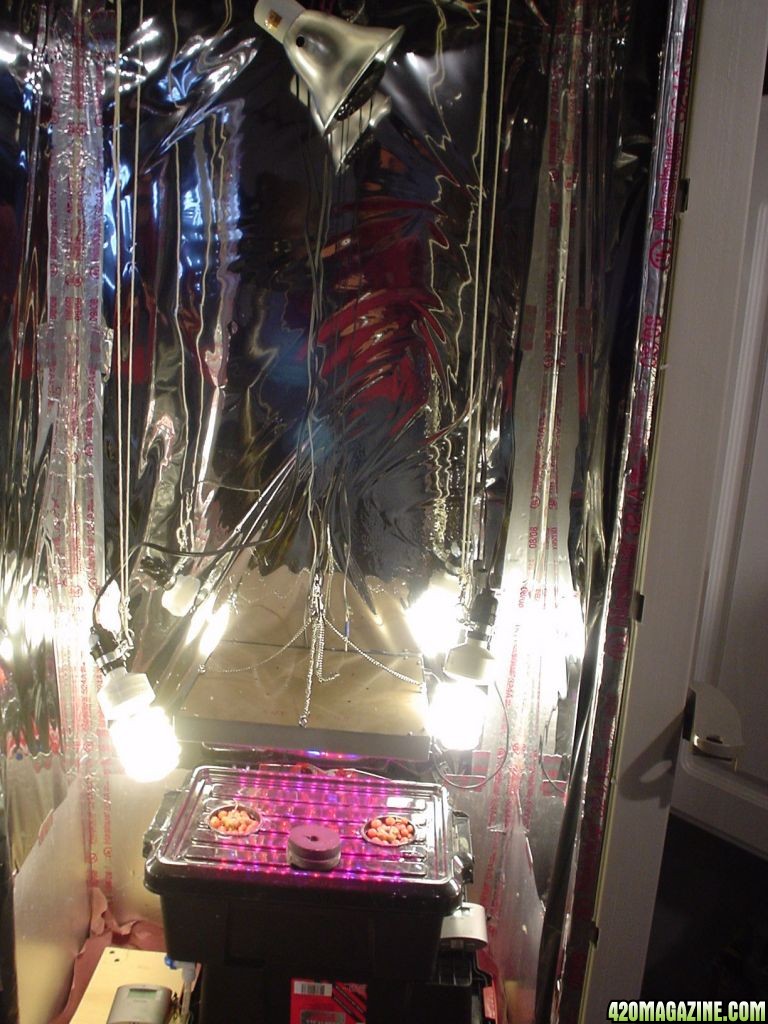
Seen in this shot - Up above is the ceramic heater (used during cold month grows and regulated via the herpastat as necessary, Mylar on the walls held on with metal tape, the 2.5 gallon tub with net cups and germinated seeds, the hanging CFLs were used initially until we found a better solution as shown later!
This picture was taken during the experimental phase of the operation. That's why the LED panel is in the shot along with the hanging CFLs.
Putting the grow box kitty corner allowed my brother to build, what he calls (and rightly so), control central:
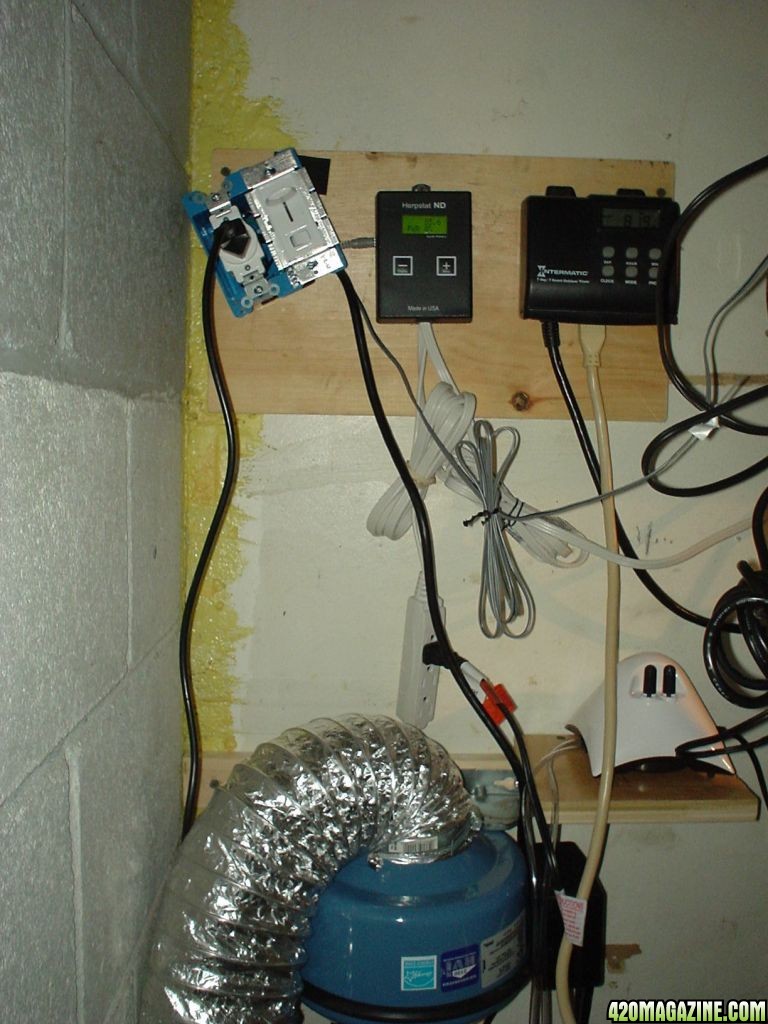
Seen here from left to right and top to bottom - dimmer switch (used to regulate the exhaust fan output (turns out it is always set to maximum), Herpastat used to regulate the ceramic heater inside the box (used during cold month grows), high quality timer, Exhaust fan and ducting, and el cheapo air pump.
No "proper" ventilation:
Air flow is critical for growing our chosen crop. Air needs to move through the box for odor control, for the health and development of the plants and for temperature management. To accomplish this we cut two 4 inch holes in the back of the box. One down low...the other up near the top. We connected our exhaust fan and ducting to the top hole so that we can pull the hot air out of the box during hot months (afterall...hot air rises). We connected some ducting to the bottom hole and laid that on the floor outside the box. This ducting will have to suffice as our supply of air from inside the unheated and uncooled garage. With the exhaust fan turned on we found that we got a very acceptable air flow through the box. A small carbon filter was added to the air flow to minimize the odor in the garage.
Temperature management:
As noted above we have the normal lighting used for growing pot (HPS or MH). Our hood for these bulbs wouldn't fit in the box and we were pretty sure that even if it did there was no way we could control the temperature. We tested it out anyway by creating a new housing for a bulb. With small fans (all we could fit in the box when in full operation) the internal temperature of the box topped out at over 110 degrees fahrenheit. MUCH too hot for a grow. Earlier experience showed that a LED panel we had purchased was not going to help us out during the flowering stage (BTW our experience has shown that LED panels work very well for getting clones rooted and for maintaining a mother plant (although a high output compact fluorescent light (CFL) and LED panel work best). My brother, when checking bulbs at his local Home Depot, spotted something he thought (and he was right) he found something that would help us out with our light/temperature problem. What he found were high output CFLs. These bad boys put out 300 watts of light. These bulbs put out 4200 lumens each at 300w (btw using 68w of power) we were confident that, with enough of them, we could get a very acceptable yield from our chosen strain.
With the size of the box we determined that we could make a housing that would fit 5 of these bulbs. Thereby producing 1500w of light and keep the temperature at an acceptable level. Construction began immediately. The finished product is show here:

This was taken from down low looking up at the light box after it was hung in the grow box. As shown we added mylar to the inside of the light box, used aluminum angle iron for holding the glass in place.
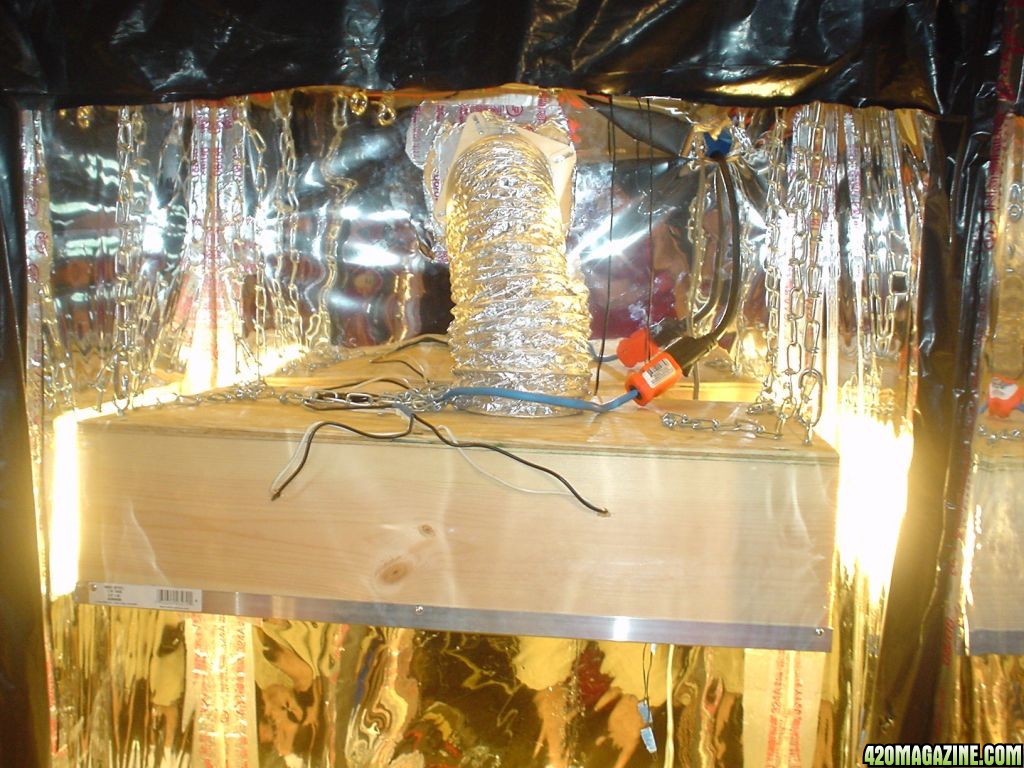
To help mitigate the temperature, a 4" hole was cut into the top of the box and attached directly to the exhaust fan.
*While we haven't come into the winter months yet with this light box we have decided that to help keep the temperature high enough (a unique problem when using CFLs as opposed to HPS or MH lights) we plan on switching the ducting in the back of the box so that we pull the cooler air from the bottom of the box thereby pumping air into the box via the ducting in the top of the box (thru the light box). We are hoping that the lights will help warm the box. We always have the ceramic heater and herpastat (to regulate it) to aid in keeping the temperature up as needed.
Our subsequent testing showed that the box reached a maximum temperature of 82 degrees fahrenheit. PERFECT!
Now onto the grow set up.
It's really very simple. We have a 2.5 gallon tub (light tight to prevent the development of algae) and lid. We found these at Home Depot. We are always on the look out for these types of boxes. They are not always easy to find. It is important that the lid and the tub is very sturdy. You don't want the rubbery type of tub or lid but a very hard plastic type.
Two 3" holes were cut into the lid to house the net cups. A third, smaller, hole was cut into the lid as well. This was to facilitate checking the air pump functionality (more on that later) and to aid in adding water as needed. The tub was further prepared but adding a plastic spigot to the bottom. High quality silicone was used to seal the spigot hole to prevent leakage. Note...painters caulk is NOT recommended for the prevention of leakage.
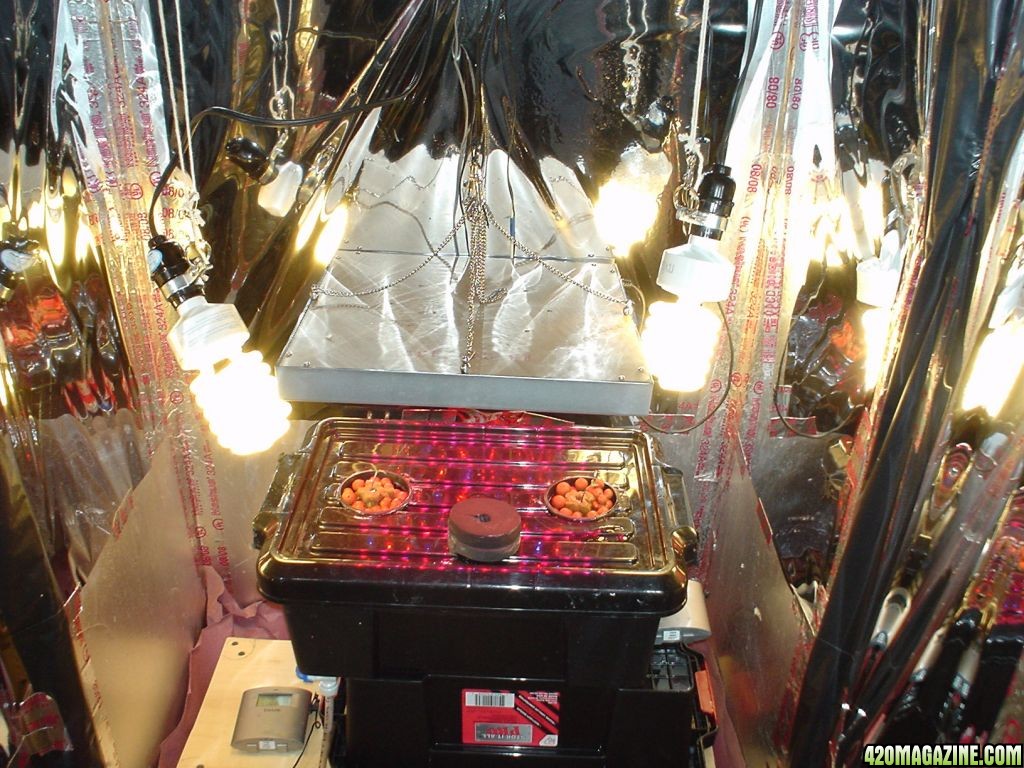
Net cup lids are covering the water "fill" hole to prevent light from reaching the water inside the tub (algae prevention) and the spigot can be seen in the front left corner of the tub with a drain line hanging from it. It is sitting on another, upside down, tub to raise it off the floor of the grow box. A homemade stool was later used to replace that tub. This picture was taken during the experimental phase of the operation. That's why the LED panel is in the shot along with the hanging CFLs.
We chose to grow Northern lights for a number of reasons. Those reasons include: High yield, past success, and manageable size of plant (height) as shown here:
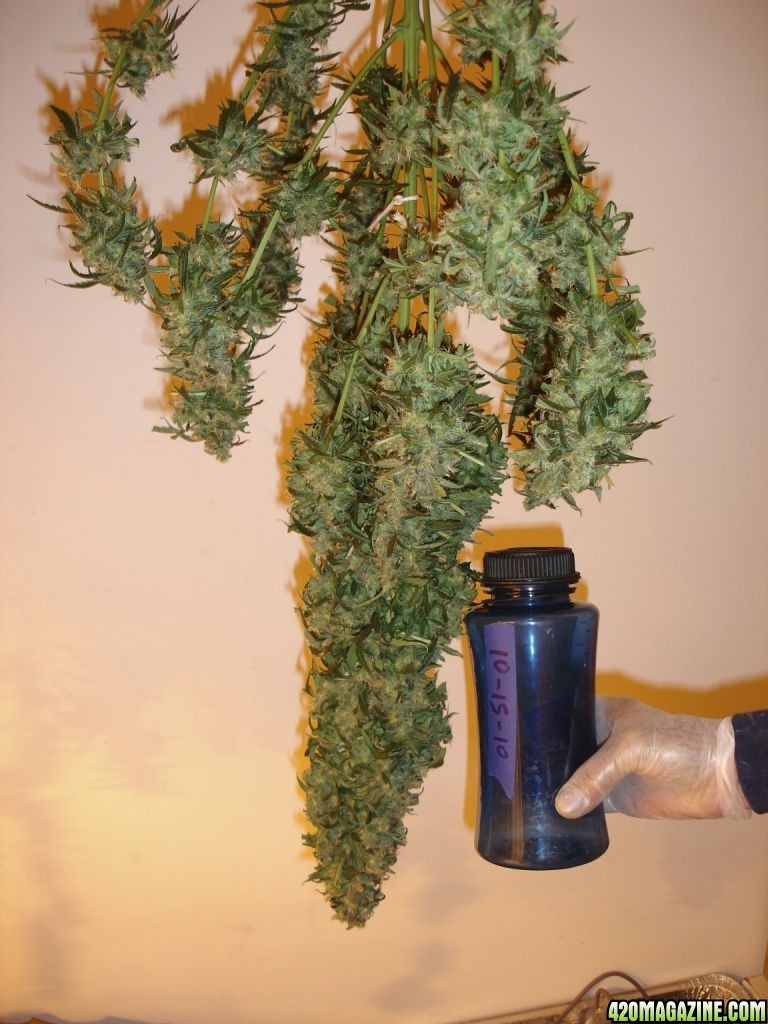
This "glamour" shot was taken from a previous grow operation in a much more traditional environment. The bottle I am holding is a one quart bottle used to show proportion.
The only difference between the grow that produced this plant and the current operation is the use of MH lights (400w) rather than the CFL lights of our current set up. While our current set up would not, and did not, produce this size kola we are VERY pleased with the yield using CFLs.
There is NO substitute for using HPS or MH lights. If your grow room/set up can use HPS or MH lights, use them. You will not be disappointed!
While the above plant, hanging in the drying phase, topped out at about 3 feet in height (give or take a few inches as it was not measured) we were concerned that it was still going to be too tall for our grow box/light box combination. We decided that, for the first time, we would grow a mother plant and take some clones. All of our research about mothers and clones failed to mention something we found to be VERY important and a major value-add to using clones. That being plant size. We speculated, and hoped, that taking clones, from as close to the top of the mother as possible, would result in producing a shorter, more bud to stem ratio, plant. While nothing we found in our research came out and said it, we were hopeful that would be the case. We were right. As seen later the 2 plants topped out at 22" in height and produced more smokable product from top to bottom.
So back to the set up. We have the tub. Now to add 2 small holes to the very top of the tub (as close as possible to the top edge) to allow us to feed the 2 lengths of air tubing through. Attached to each of the air tubes are 6" air stones. Pumping air into the water is essential to aid in the production of healthy plants. The other end of the tubes are attached to an aquarium air pump (seen in the Control Central photo).
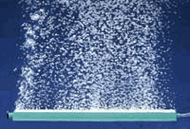
The growing medium:
We use water. Water and nutrients. Simple and effective. We don't use any "spraying" system because we don't like how dependent the life of our plants were to the pump not failing. If the pump fails in a "spray" system then plants suffer and can die (if pump failure is not detected in time). Any time lost from a pump failure results in an increase time for the plant producing buds. We don't like the idea of more points of failure. Therefore we went with a modified hydro system. Out plants' roots sit in the water and nutrients. There is no chance of them drying out or not getting all that they need to grow and be healthy at all times. The air stones provide more than enough oxygen and we supplement the health of the roots with an ounce or two of Hydrogen Peroxide once a week. Our roots are always healthy and plentiful resulting in strong sturdy plants and buds. The nutrient mix used is dependent on the liquids you buy. We use to change the water (drain and replenish) every week with the new weekly mix. We found that to be very time consuming (especially in our old operation where we used much bigger tubs and much more water) and unnecessary. Because during the peak of flowering the plants use a LOT of water we "change" the mix by adding water with the new mix as the tub requires. This simplifies the process and makes maintenance a breeze. The only time we completely drain the tub and replace the water is the last week of flowering and we replace the water with clear, Ph balanced water.
As you can see here, our roots are strong, healthy and there are a lot of them.
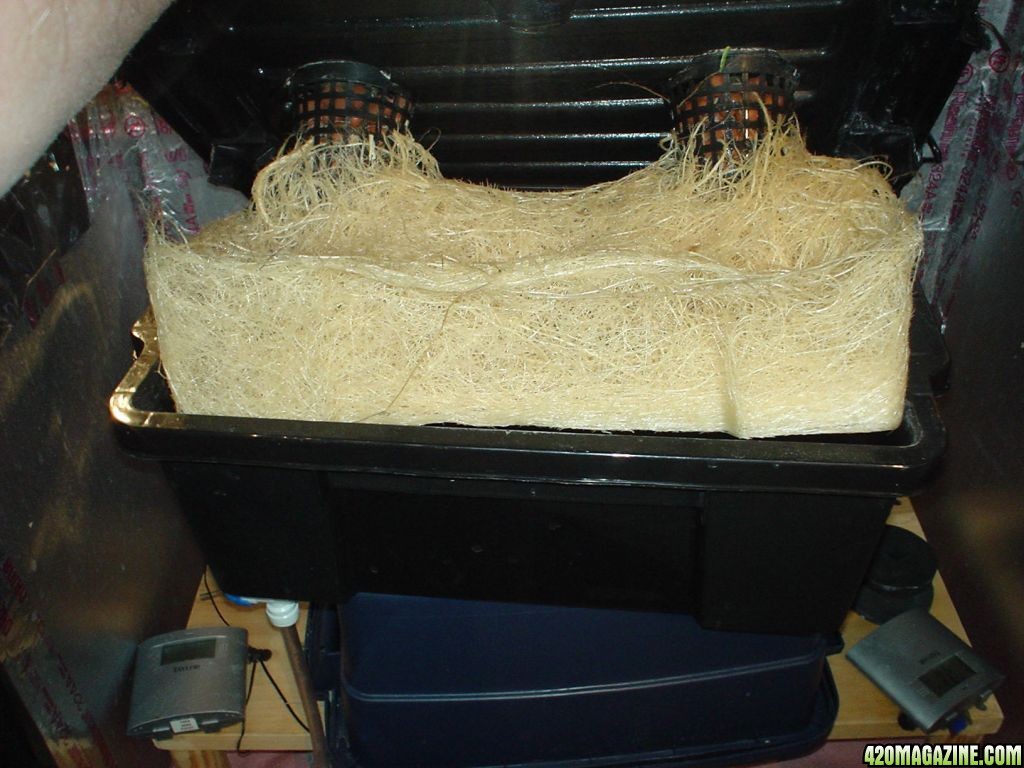
The air stones are in there somewhere. Easy to dig out, clean and re-use
As you can see here these 2 Northern Lights grew to be strong healthy plants producing a VERY considerable yield (in our experience anyway). While we don't have the dry weight just yet (we harvested last night 9/9/2009) we are very pleased with the resulting crop considering the lights used were $13 300w CFLs (albeit 5 of them).
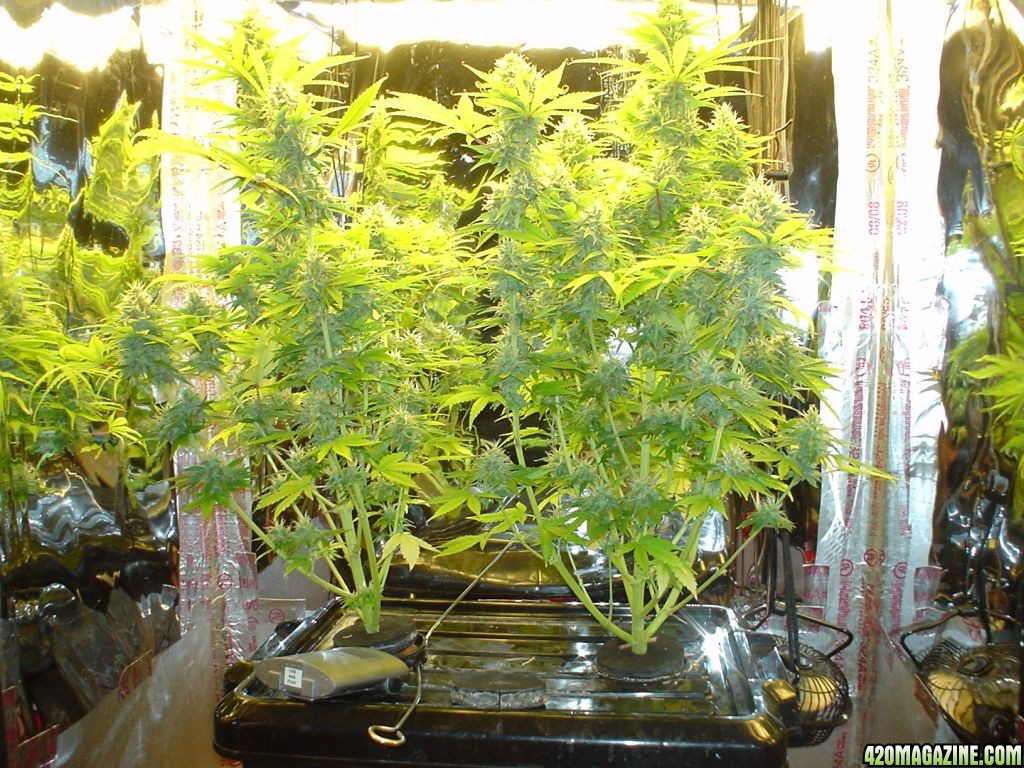
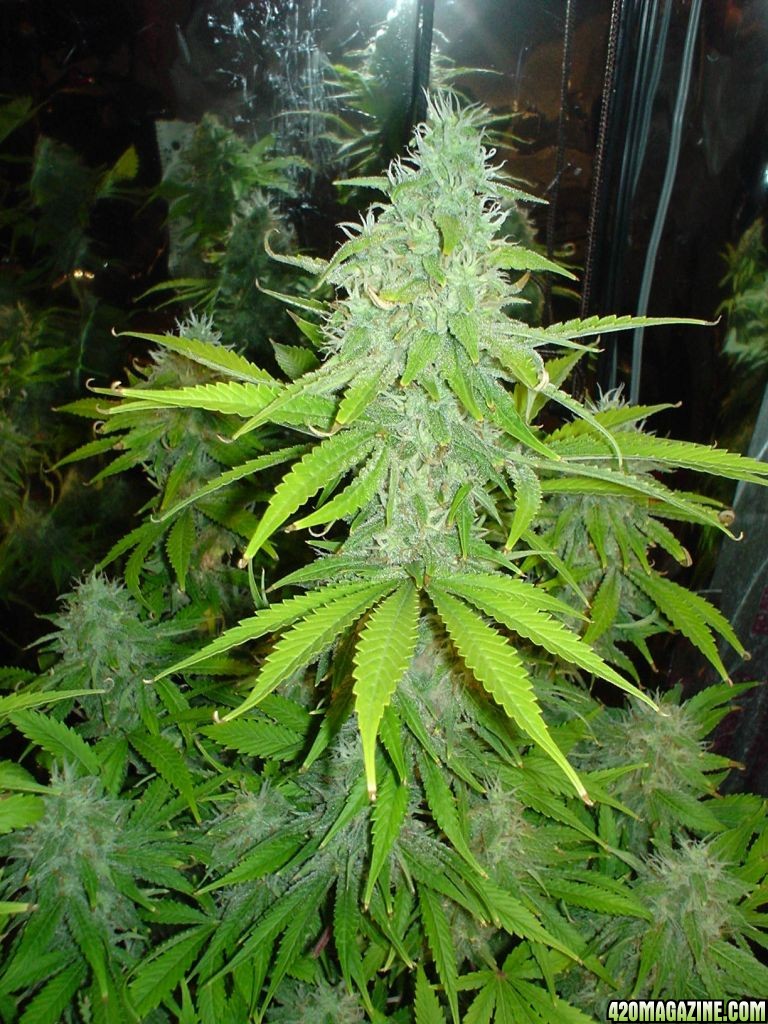
This is documentation of our first experience growing with only CFLs. Our hope is that we were able to provide answers to the many questions we ourselves had when we began considering to attempt this. As we had no other option but to use this type of lighting we were determined to get the best yield and highest quality possible with the limitations put upon us. We believe we have successfully met those goals.
If you have any questions or comments or suggestions we would love to hear them.
Skooter Clowns
We (my brother and I) needed to set ourselves up a small grow. Like you, the readers of this forum, we wanted a steady supply, and hefty stash, of quality smoke. We also like the ability to do it. We've had very successful grows, on a larger scale, when we first used the method detailed in these posts. We find it very satisfying doing this. Almost as satisfying as smoking the stuff!
The plan
To use our proven method of growing some quality herbage using our method of hydroponic growing.
This method has worked great for us in the past and we were determined to successfully modify the operation to fit our current location limitations.
The conditions and limiting factors
This time our grow location and limiting factors are numerous. We had to significantly modify our normal operation to fit the following criteria:
Limited space
No "proper" ventilation
Temperature management
As many of you know the things that we found limiting are the very things that are needed to be satisfied to have any kind of grow that can be considered successful.
What we had to work with
A small corner of an attached, unheated garage. Our modified hydroponics system that we have had great success with in the past. All the necessary equipment as listed here.
QUALITY seeds (the grow shown here is Northern Lights chosen for it's high yield, height (short) and because of our successful past experience growing this strain)
2.5 Gallon Tub with spigot (tub must be "light tight")
Lid for tub with holes cut for the net cups
2 line air pump (aquarium quality, cheap)
air line tubing
2 Air stones
Exhaust fan and ducting
Timer
Herpastat
Ceramic heater (type used for reptile pets)
Fans (small box fan type)
Chemicals (Grow, Bloom, and Micro) typical of hydroponic grows
Net cups and covers
Rock wool
Roll of Mylar
Ph/PPM meter
Ph up/down liquids
400 watt lights and ballasts (HPS and MH bulbs) (Ballasts are great because they handle both types of bulbs)
Wireless thermometer
Hydrogen Peroxide
How we addressed the conditions and limiting factors
Limited space:
As stated we only had a small corner of an unheated garage ~4 square feet. We need to find a cabinet/container that would fit in the corner and provide enough room to fit our operation.
Eventually we found at our local Lowe's a plastic cabinet made by Suncast. It needed some modifications to make it light tight but we were confident that we could accomplish this. After all we were at a Lowe's, we're very ingenious (as are most growers) and determined to get this operation up and running.
We got ourselves some rigid insulation and some "metal" tape.
We used construction adhesive to apply the rigid insulation to the box.
We needed to cut holes in the box for hanging things and to get the cords out of it etc. We also used black plastic to help "light seal" where the doors meet when closed. The interior of the box measures 18"x23" after rigid insulation was installed.
The thing looks very stealth when in full operation. Came out GREAT if I do say so myself.
Exterior of our grow box
Seen in this shot - Up above is the ceramic heater (used during cold month grows and regulated via the herpastat as necessary, Mylar on the walls held on with metal tape, the 2.5 gallon tub with net cups and germinated seeds, the hanging CFLs were used initially until we found a better solution as shown later!
This picture was taken during the experimental phase of the operation. That's why the LED panel is in the shot along with the hanging CFLs.
Putting the grow box kitty corner allowed my brother to build, what he calls (and rightly so), control central:
Seen here from left to right and top to bottom - dimmer switch (used to regulate the exhaust fan output (turns out it is always set to maximum), Herpastat used to regulate the ceramic heater inside the box (used during cold month grows), high quality timer, Exhaust fan and ducting, and el cheapo air pump.
No "proper" ventilation:
Air flow is critical for growing our chosen crop. Air needs to move through the box for odor control, for the health and development of the plants and for temperature management. To accomplish this we cut two 4 inch holes in the back of the box. One down low...the other up near the top. We connected our exhaust fan and ducting to the top hole so that we can pull the hot air out of the box during hot months (afterall...hot air rises). We connected some ducting to the bottom hole and laid that on the floor outside the box. This ducting will have to suffice as our supply of air from inside the unheated and uncooled garage. With the exhaust fan turned on we found that we got a very acceptable air flow through the box. A small carbon filter was added to the air flow to minimize the odor in the garage.
Temperature management:
As noted above we have the normal lighting used for growing pot (HPS or MH). Our hood for these bulbs wouldn't fit in the box and we were pretty sure that even if it did there was no way we could control the temperature. We tested it out anyway by creating a new housing for a bulb. With small fans (all we could fit in the box when in full operation) the internal temperature of the box topped out at over 110 degrees fahrenheit. MUCH too hot for a grow. Earlier experience showed that a LED panel we had purchased was not going to help us out during the flowering stage (BTW our experience has shown that LED panels work very well for getting clones rooted and for maintaining a mother plant (although a high output compact fluorescent light (CFL) and LED panel work best). My brother, when checking bulbs at his local Home Depot, spotted something he thought (and he was right) he found something that would help us out with our light/temperature problem. What he found were high output CFLs. These bad boys put out 300 watts of light. These bulbs put out 4200 lumens each at 300w (btw using 68w of power) we were confident that, with enough of them, we could get a very acceptable yield from our chosen strain.
With the size of the box we determined that we could make a housing that would fit 5 of these bulbs. Thereby producing 1500w of light and keep the temperature at an acceptable level. Construction began immediately. The finished product is show here:
This was taken from down low looking up at the light box after it was hung in the grow box. As shown we added mylar to the inside of the light box, used aluminum angle iron for holding the glass in place.
To help mitigate the temperature, a 4" hole was cut into the top of the box and attached directly to the exhaust fan.
*While we haven't come into the winter months yet with this light box we have decided that to help keep the temperature high enough (a unique problem when using CFLs as opposed to HPS or MH lights) we plan on switching the ducting in the back of the box so that we pull the cooler air from the bottom of the box thereby pumping air into the box via the ducting in the top of the box (thru the light box). We are hoping that the lights will help warm the box. We always have the ceramic heater and herpastat (to regulate it) to aid in keeping the temperature up as needed.
Our subsequent testing showed that the box reached a maximum temperature of 82 degrees fahrenheit. PERFECT!
Now onto the grow set up.
It's really very simple. We have a 2.5 gallon tub (light tight to prevent the development of algae) and lid. We found these at Home Depot. We are always on the look out for these types of boxes. They are not always easy to find. It is important that the lid and the tub is very sturdy. You don't want the rubbery type of tub or lid but a very hard plastic type.
Two 3" holes were cut into the lid to house the net cups. A third, smaller, hole was cut into the lid as well. This was to facilitate checking the air pump functionality (more on that later) and to aid in adding water as needed. The tub was further prepared but adding a plastic spigot to the bottom. High quality silicone was used to seal the spigot hole to prevent leakage. Note...painters caulk is NOT recommended for the prevention of leakage.
Net cup lids are covering the water "fill" hole to prevent light from reaching the water inside the tub (algae prevention) and the spigot can be seen in the front left corner of the tub with a drain line hanging from it. It is sitting on another, upside down, tub to raise it off the floor of the grow box. A homemade stool was later used to replace that tub. This picture was taken during the experimental phase of the operation. That's why the LED panel is in the shot along with the hanging CFLs.
We chose to grow Northern lights for a number of reasons. Those reasons include: High yield, past success, and manageable size of plant (height) as shown here:

This "glamour" shot was taken from a previous grow operation in a much more traditional environment. The bottle I am holding is a one quart bottle used to show proportion.
The only difference between the grow that produced this plant and the current operation is the use of MH lights (400w) rather than the CFL lights of our current set up. While our current set up would not, and did not, produce this size kola we are VERY pleased with the yield using CFLs.
There is NO substitute for using HPS or MH lights. If your grow room/set up can use HPS or MH lights, use them. You will not be disappointed!
While the above plant, hanging in the drying phase, topped out at about 3 feet in height (give or take a few inches as it was not measured) we were concerned that it was still going to be too tall for our grow box/light box combination. We decided that, for the first time, we would grow a mother plant and take some clones. All of our research about mothers and clones failed to mention something we found to be VERY important and a major value-add to using clones. That being plant size. We speculated, and hoped, that taking clones, from as close to the top of the mother as possible, would result in producing a shorter, more bud to stem ratio, plant. While nothing we found in our research came out and said it, we were hopeful that would be the case. We were right. As seen later the 2 plants topped out at 22" in height and produced more smokable product from top to bottom.
So back to the set up. We have the tub. Now to add 2 small holes to the very top of the tub (as close as possible to the top edge) to allow us to feed the 2 lengths of air tubing through. Attached to each of the air tubes are 6" air stones. Pumping air into the water is essential to aid in the production of healthy plants. The other end of the tubes are attached to an aquarium air pump (seen in the Control Central photo).

The growing medium:
We use water. Water and nutrients. Simple and effective. We don't use any "spraying" system because we don't like how dependent the life of our plants were to the pump not failing. If the pump fails in a "spray" system then plants suffer and can die (if pump failure is not detected in time). Any time lost from a pump failure results in an increase time for the plant producing buds. We don't like the idea of more points of failure. Therefore we went with a modified hydro system. Out plants' roots sit in the water and nutrients. There is no chance of them drying out or not getting all that they need to grow and be healthy at all times. The air stones provide more than enough oxygen and we supplement the health of the roots with an ounce or two of Hydrogen Peroxide once a week. Our roots are always healthy and plentiful resulting in strong sturdy plants and buds. The nutrient mix used is dependent on the liquids you buy. We use to change the water (drain and replenish) every week with the new weekly mix. We found that to be very time consuming (especially in our old operation where we used much bigger tubs and much more water) and unnecessary. Because during the peak of flowering the plants use a LOT of water we "change" the mix by adding water with the new mix as the tub requires. This simplifies the process and makes maintenance a breeze. The only time we completely drain the tub and replace the water is the last week of flowering and we replace the water with clear, Ph balanced water.
As you can see here, our roots are strong, healthy and there are a lot of them.
The air stones are in there somewhere. Easy to dig out, clean and re-use
As you can see here these 2 Northern Lights grew to be strong healthy plants producing a VERY considerable yield (in our experience anyway). While we don't have the dry weight just yet (we harvested last night 9/9/2009) we are very pleased with the resulting crop considering the lights used were $13 300w CFLs (albeit 5 of them).
This is documentation of our first experience growing with only CFLs. Our hope is that we were able to provide answers to the many questions we ourselves had when we began considering to attempt this. As we had no other option but to use this type of lighting we were determined to get the best yield and highest quality possible with the limitations put upon us. We believe we have successfully met those goals.
If you have any questions or comments or suggestions we would love to hear them.
Skooter Clowns





 id you use all 5 of the lights on these to NLs?
id you use all 5 of the lights on these to NLs?



